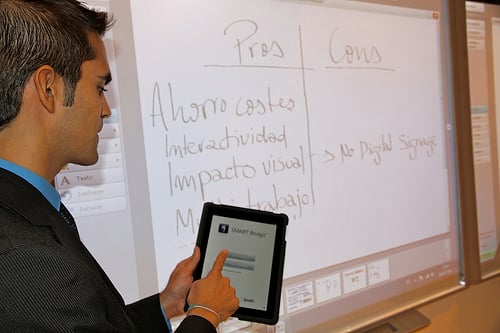Published on
Engagement: Deciding What Technology Is Worthwhile In The 21st Century Classroom

Engagement is the key to deciding whether technology is worthwhile in the classroom. Technology is a tool in the arsenal of the educator and the educator is always striving to engage their students. Engagement is the ultimate student response system.
What engages students? Here are some recent successes in our classrooms in Addison and what compelled us to put them in the classroom.
Smart brand Smartboards
In the Addison district we have had “smart” boards for some time. The first boards used were Promethean boards and they were purchased before my time in the district and from what I understand, quite hastily. We had only a few teachers that even understood the Promethean software and that is a major issue when bringing a technology into the classroom.
Smartboards are engaging but you cannot engage students with a technology that you are unable to use. There used to be a video on YouTube called “The Class” that was a parody of the “The Office” (which got it blocked for copyright reasons) that demonstrated the pitfalls of giving teachers technology that they were not trained properly to use. The video is hilarious but the message is all too common.
For Technology Directors like myself, who get way too little Professional Development time with their teachers (as I do), the technology needs to be user-friendly. The Promethean software is not user friendly, the Smart software is. We purchased four boards this past school year and added another this year. We are using bond money to put a Smart brand board into every classroom for the 2012 school year.
iPads
Apple’s iPad Education site says it well:
“iPad inspires creativity and hands-on learning with features you won’t find in any other educational tool—on a device that students really want to use.”
iPads are scary for some educators because we must ask the question: where do we draw the line between educational device and mindless video game? Then again, does a line need to be drawn? I ran across Miles McFarlane’s work with his students and the game Minecraft earlier this week while working on a blogpost. I took personal interest in his work because my 11-year old son is an avid fan of Minecraft and I had been doubting the educational value of the game. Here is a quote from a recent post from Miles that really stuck out to me:
“A small group of normally disengaged students were suddenly front and centre in the classroom sharing their video gaming expertise, leading the way with their considerable skill set using Minecraft. I even had one of them ask for the most challenging Greek structure to recreate because he wanted something hard to do!”
That is engagement and it is a video game. A video game that many educational experts would call mindless and addicting.
I had my doubts about the iPad when it first came out. I have been an iPhone user for awhile and to me it just seemed like an oversized iPhone. The first iteration was cool, in a geeky way, but I remember telling one of our teachers that I didn’t see it representing much value in our classrooms. It didn’t even support Flash and at that time you needed Flash for just about everything. The iPad Generation 1 was not worthwhile for our classrooms. Things changed with the iPad 2 and not necessarily because of the hardware but because of the ecosystem, or apps. Flash became less of a hurdle as app developers released apps that covered the things that we need in education. Our elementary principal received a grant for about $15,000 this year and devoted that to putting two iPads in every classroom from K-2. We have seen some great successes since deploying the units.
Notice in both of these cases that there is a little bit of trial and error involved in finding those things that are worthwhile in the classroom. For every Smartboard or iPad in the classroom there is Nook Color running Android in my office that didn’t quite make the cut as worthwhile.
I think for technology decision makers it is important to do your research and reach out to other education technology professionals to find out what is working for them. The MACUL Conference in Michigan and the national ISTE Conference are other great places to find out what is working. Cut through the sales hype and ask the hard questions of educators using the technology in their classrooms. It is those educators that are in the trenches and the technology decision makers that serve them that can give you the best insight to what will work or how to find what works.
Author Perspective: Administrator


